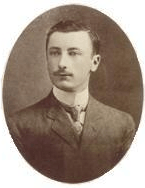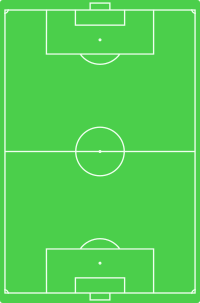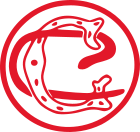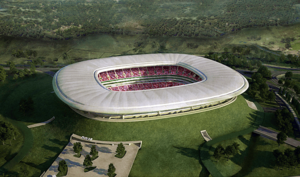C.D. Guadalajara facts for kids
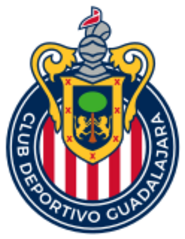 |
|||
| Full name | Club Deportivo Guadalajara S.A. de C.V. | ||
|---|---|---|---|
| Nickname(s) | Chivas (Goats) Chivas Rayadas (Striped Goats) Rebaño Sagrado (Sacred Herd) Rojiblancos (Red and Whites) Campeonísimo (Great Champion) |
||
| Short name | GDL | ||
| Founded | 8 May 1906, as Unión Football Club 1923, as Club Deportivo Guadalajara |
||
| Ground | Estadio Akron | ||
| Capacity | 48,071 | ||
| Owner | Grupo Omnilife | ||
| President | Amaury Vergara | ||
| Head coach | Gabriel Milito | ||
| League | Liga MX | ||
| Clausura 2025 | Regular phase: 11th Final phase: Did not qualify |
||
|
|
|||
Club Deportivo Guadalajara S.A de C.V. is a famous Mexican football club. It is often called "Chivas" (which means "Goats"). The club is based in the city of Guadalajara, Jalisco. They play in Liga MX, which is the top football league in Mexico.
The club started in 1906 as Unión Football Club. In 1908, its name changed to Guadalajara Football Club. Then, in 1923, it became Club Deportivo Guadalajara. Chivas was one of the first teams in Mexico's professional football league, which started in 1943. It is one of only seven teams that have never been moved down to a lower league.
Since 2010, Guadalajara has played its home games at Estadio Akron in Zapopan. Before that, they played at Estadio Jalisco. Chivas is special because it is the only football club in Mexico that only signs Mexican players. The team is known for developing its own talented young players. Many famous Mexican players, like Javier Hernández, Carlos Vela, and Carlos Salcido, started their careers here.
Chivas is one of Mexico's most successful teams. They have won 12 league titles. They also hold the record for the longest winning streak at the start of a season, with 8 wins in 2010. On the international stage, Guadalajara has won two CONCACAF Champions Cup/League titles. They were also runners-up in the Copa Libertadores in 2010.
In 2016, a study showed that Guadalajara was the most popular team in Mexico. About 44.1% of football fans in the country supported them. In 2020, Forbes magazine said the club was worth around $311.5 million. This made it the most valuable team in the Mexican league.
Contents
- Club History
- How Chivas Started
- The Professional Era: "Almost There!" (1943–1953)
- The "Great Champion" Era (1955–1970)
- Tough Times (1971–1983)
- Getting Back on Track (1983–1991)
- The "Promotora" Era (1992–2002)
- New Owners (2002–2011)
- More Difficult Years (2011–2015)
- The Comeback (2015–2018)
- Recent Years (2018–Present)
- Team Colors and Badge
- Home Stadiums
- Team Rivalries
- Fan Support
- Team Management
- Players
- Manager History
- Team Achievements
- International Game Records
- See also
Club History
How Chivas Started
The team was founded by Edgar Everaert. He came to Mexico in 1906. The club was first called "Unión" because players from different countries played together. Most of them worked at a store called Fábricas de Francia. Everaert was their coach. Some Spanish and English players also joined Unión Football Club.
The club's first game was against Gimnasio Atlético Occidental. Rafael Orozco coached Unión in that match. He and his brother, Gregorio, were the first Mexican players at Unión. The Orozco family helped the club a lot. Rafael's grandmother, Nicolasa Sáinz, let her home be the club's first meeting place. His uncle, Sabino Orozco, even gave land for the club's first field.
Everaert noticed that European teams named after their cities got more fan support. So, in 1908, the club decided to change its name. They renamed it Club Deportivo Guadalajara. This was to make people in the city feel more connected to the team. After the Mexican Revolution, amateur football grew. Guadalajara won 13 amateur titles between 1906 and 1943. Their first title was in 1908. During this time, the oldest rivalry in Mexican football began between Guadalajara and America.
In 1943, the team decided to only have Mexican-born players. This was because Mexicans felt strongly about their national identity.
The Professional Era: "Almost There!" (1943–1953)
In 1943, professional football began in Mexico with the Liga Mayor. Guadalajara had a tough start in these early years. But in the 1948–49 season, they finished third. In the same year, during a game against Atlas, Guadalajara was called "Chivas Locas" (Crazy Goats). At first, this was meant as an insult. But the team became so popular that they adopted "Chivas" as their nickname.
In the 1951–52 and 1954–55 seasons, the team finished second in the league. This led to them being nicknamed "Ya Merito" ("Almost There!").
The "Great Champion" Era (1955–1970)
The 1956 season brought together amazing players. These included Salvador "Chava" Reyes, Jaime "El Tubo" Gomez, and Isidoro "Chololo" Díaz. This group became known as El Campeonísimo (The Great Champion). They are considered one of the best teams in Mexican football history.
Guadalajara won its first championship in 1956–57. Salvador Reyes scored a goal in the last minute to secure the win. With coaches like Javier de la Torre, the team won seven league championships. They also won two cups and three CONCACAF titles. They were the only team in Mexico to win four league championships in a row. This happened from 1958–59 to 1961–62. El Campeonísimo became famous worldwide. In 1964, they played games in Europe against teams like FC Barcelona.
Tough Times (1971–1983)
The 1970s and early 1980s were difficult for Guadalajara. In the 1970–71 season, the team almost got moved down to a lower league. They were nicknamed "Las Chivas Flacas" (The Lean Goats) because they weren't playing well.
In 1981, a sad event happened. The team bus was in an accident, and midfielder Jose "Pepe" Martínez passed away. Despite this, the team finished third in the 1980–81 season. In 1981–82, they again barely avoided being moved down.
Getting Back on Track (1983–1991)
Things started to get better when Alberto Guerra became coach. He used to be a player for Guadalajara. In the 1982–83 season, Guadalajara finished seventh and made it to the playoffs. They reached the finals for the first time since the playoff system started. However, they lost to Puebla F.C. in a penalty shootout.
They reached the finals again in 1983–84 but lost to America. The club stayed competitive through the 80s and early 90s. Their best year was 1986–87. They finished first in the regular season and won the championship against Cruz Azul. Key players during this time included Benjamín Galindo and Eduardo de la Torre.
The "Promotora" Era (1992–2002)
By the late 1980s, Guadalajara faced money problems. The team decided to create a special group called La Promotora Deportiva. This group would manage the team for 10 years, starting in 1992. Salvador Martinez Garza was in charge.
The new leaders brought back coach Alberto Guerra. They also bought many important players like Missael Espinoza and Alberto Coyote. The team also used young players from their own youth academy. These included Paulo Cesar "Tilon" Chavez and Joel "Tiburon" Sanchez. The press called the new team Las Superchivas. But they were eliminated early in the playoffs.
In 1994–95, the club sold its TV rights to Televisa. Many fans didn't like this because Televisa also owned Club América. Guadalajara finished first in the 1993–1994 regular season. But they lost to Club Necaxa in the semifinals.
In 1996, the league changed to two short seasons per year. Under coach Ricardo Ferretti, Guadalajara won its 10th championship in the Verano 1997 season. They beat Toros Neza with a total score of 7–2. They reached the finals again in 1998 but lost to Necaxa.
New Owners (2002–2011)
After 10 years, La Promotora was still in debt and put up for sale. On October 31, 2002, Jorge Vergara bought the team. He was a businessman from Guadalajara. Vergara owned a company called Grupo Omnilife. He removed most of the sponsors from the team's jersey. He also tried to make the "Las Chivas" name a big brand. He put the name on magazines, toothbrushes, and even a cola drink.
In 2004, the club announced they would build a new stadium, Estadio Akron. In the Apertura 2004 season, Guadalajara played exciting football. They finished third in the league. Players like Oswaldo Sánchez, Ramon Morales, Omar Bravo, and Adolfo Bautista became fan favorites. They reached the finals but lost to UNAM in a penalty shootout.
In the 2005 Copa Libertadores, they beat strong teams like Boca Juniors. They reached the semifinals but lost. Under coach José Manuel de la Torre, Chivas won its 11th championship in the Apertura 2006 season. They beat Toluca 2–1 in the final game, winning 3–2 overall. This made them the team with the most titles in the league at that time.
After this championship, some key players left. Coaches also changed often. In 2009, José Luis Real became coach. He led the team to a great start in the 2010 Bicentenario tournament. They won their first 8 games in a row. Young players like Javier Hernández (who later joined Manchester United) became stars. Chivas reached the championship stage but lost in the first round.
On July 30, 2010, Chivas played their first game in the new Estadio Akron. It was against Manchester United. Chivas won 3–2. Javier Hernández scored for Guadalajara in the first half. In August 2010, Chivas played in the Copa Libertadores finals against a Brazilian club. They lost 5–3 overall, becoming the second Mexican club to reach that final.
More Difficult Years (2011–2015)
After José Luis Real left in 2011, Chivas had a hard time. They changed coaches nine times in three years. The club was in danger of being moved down to the second division. In 2012, Johan Cruyff was hired as an advisor but left after nine months.
Many important players were put on the transfer list in 2013. Jose Luis Real returned as coach but was soon let go. Ricardo La Volpe was briefly coach in 2014. Then Carlos Bustos took over but resigned after poor results. On October 7, 2014, José Manuel de la Torre was appointed coach.
The team started the 2015 Clausura season tied for last place. But they improved a lot. They won important games and finished fifth, making it to the playoffs for the first time since 2012. However, they had a bad start to the 2015 Apertura season. On September 14, 2015, De la Torre was released.
The Comeback (2015–2018)
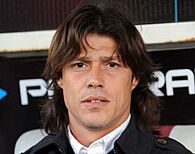
On September 18, 2015, Matías Almeyda became the new manager. He wanted to "awaken the giant." Almeyda's attacking style quickly brought wins. They won their first four matches, including a 2–1 victory against rivals Club América.
On November 4, Chivas won its third Copa MX title. They beat Club León 1–0. In May 2016, the club qualified for the Clausura 2016 Liguilla. Their good performance helped them avoid relegation troubles.
On May 21, 2016, owner Jorge Vergara announced that Chivas would no longer work with Televisa. Instead, they started Chivas TV, their own channel for live games and interviews. Chivas TV had some issues at first but improved over time.
On July 10, 2016, Chivas won their first Supercopa MX title. They beat Veracruz 2–0. This qualified them for the Copa Libertadores, but they did not participate due to format changes.
On April 19, 2017, Chivas won their fourth Copa MX title. They beat Monarcas Morelia in a penalty shootout. The next month, they won their twelfth league title. They beat Tigres UANL 4–3 overall in the Clausura championship final. This made Chivas the first team in Mexican history to win two "Doubles" (league and cup in one season).
On April 25, 2018, Guadalajara won the CONCACAF Champions League final. They beat Major League Soccer team Toronto FC in a penalty shootout. This win qualified them for the 2018 FIFA Club World Cup. However, Almeyda left the club on June 11, 2018. José Cardozo was appointed manager the next day.
Recent Years (2018–Present)
At the 2018 FIFA Club World Cup, Chivas finished sixth. In March 2019, Cardozo was let go. Tomás Boy became his replacement. On November 15, 2019, club owner Jorge Vergara passed away. His son, Amaury Vergara, became the new president.
On November 26, Ricardo Peláez became the new sporting director. Luis Fernando Tena was named the new manager. Tena was let go in August 2020. Victor Manuel Vucetich then became manager. Chivas reached the semifinals of the Guardianes 2020 tournament but lost to Club León. In Guardianes 2021, they were knocked out in the reclassification round.
In the Torneo Apertura 2021, Chivas finished 10th. This was their lowest finish in a while. Vucetich was sacked, and Marcelo Michel Leaño became caretaker manager. Leaño was later appointed permanent manager for Clausura 2022. He was sacked after getting only 11 points from 13 games. Ricardo Cadena took over as caretaker. He led Chivas to a 4-game winning streak. They reached the quarter-finals but lost to rivals Atlas.
For Apertura 2022, Cadena became permanent manager. The team struggled. They were knocked out in the reclassification phase.
On October 21, 2022, Fernando Hierro was announced as the new sporting director. Ten days later, he appointed Veljko Paunović as coach. Many people were unsure about this choice. But Paunović led Chivas to a top 3 finish in Clausura 2023. They reached the league final for the first time since 2017. On May 28, 2023, Chivas lost the final to Tigres UANL in extra time.
After a disappointing quarter-final exit in Apertura 2023, Veljko Paunović left the club on December 15, 2023. Fernando Gago was announced as his replacement five days later. Gago led Chivas to the semifinals in Clausura 2024, where they were eliminated by rivals Club América.
On May 29, 2024, Fernando Hierro announced his departure. On October 10, 2024, Fernando Gago also left the club to join Boca Juniors. This happened after weeks of rumors.
On December 2, 2024, Óscar García Junyent was appointed head coach for the Clausura 2025 season. New players like Luis Romo and Alan Pulido joined the team. However, Chivas struggled at the start of Clausura 2025. García Junyent received a 3-match ban in January.
On February 28, 2025, the remaining Spanish sporting directors left. Javier Mier took over. The next day, García Junyent's departure was announced. Gerardo Espinoza was appointed on March 3rd for the rest of the season.
Chivas had a promising start against Club America in the CONCACAF Champions Cup. They won the first leg 1-0 and drew 0-0 in Liga MX. But they lost the second leg 4-1. This led to them failing to qualify for the playoffs, finishing 11th. Gerardo Espinoza then left the club.
After much speculation, Guadalajara announced Argentine manager Gabriel Milito on May 26, 2025. New players like Richard Ledezma, Diego Campillo, Efrain Alvarez, and Bryan Gonzalez joined the team.
Team Colors and Badge
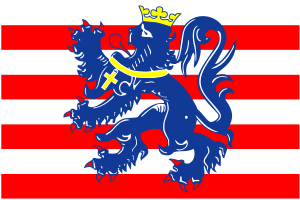
Team Colors
The club's uniform uses three colors: red, white, and blue. When the team first started, their kit was all white. In 1908, they changed their uniform. It was designed to look like the kit of the founder's favorite team, the Belgian Club Brugge K.V.. They copied the vertical stripes and colors from Club Brugge's uniform at that time. (Club Brugge has since changed its colors).
Some historians say the colors came from the French flag. This is because some of the first players were French. It was also a tribute to the factory where many players worked, Fábricas de Francia. Even though the club later decided to focus only on Mexican players, they kept the Bruges colors and pattern. This was to honor the European founders.
Team Crest
When the team was renamed Club Guadalajara in 1908, they used the letters C.G. on their jersey. The first proper crest was designed a few years later. It still used the team's initials, but they were placed inside a circle.
In 1910, a second crest was made. It used the same C.G. initials. The "C" was replaced with a snake wrapped around a "G" shaped like a horseshoe. These initials were also inside a red circle. This design was used on special jerseys in 2006 for the club's 100th anniversary.
Starting in 1917, the club used a crest similar to its modern one. It was a vertical rectangle with a blue border. Inside, it had five red and six white stripes, like the team's jersey. The center had a blue diamond border with a "G" inside.
Guadalajara's modern crest was designed in 1923. It is based on the coat of arms of the city of Guadalajara, Jalisco. The crest also has a blue circle with the word Guadalajara. It includes red and white stripes, like the 1917 crest. Over the years, stars have been added to the crest. Each star represents a championship the team has won, totaling twelve. The modern crest was designed by brothers Everardo and Jose Espinosa, Angel Bolumar, and Antonio Villalvazo. They were all players or directors of the team.
- Current kit provider: Puma (since Apertura 2016)
- Current sponsors: Caliente, Tecate, Omnilife, Volaris, Lubricantes Akron, Coca-Cola, eFootball, MG Motor, Mercado Pago, Powerade, Carl's Jr., Perdura, Casther, Megacable, Mercedes-Benz, GNP Seguros, Axen Capital, Amazon Prime, Krispy Kreme, Autobuses Futura
Home Stadiums
Parque Oblatos
From the 1930s to 1960, Guadalajara played in a small stadium called "Parque Oblatos." It was first built for another team, Oro. Chivas moved into the stadium soon after. In the 1950-51 season, Atlas won the league title by beating Chivas at Parque Oblatos.
In the 1956–57 season, Chivas won their first ever title at Parque Oblatos. Salvador Reyes scored the winning goal. The stadium was very important to Chivas. But by the 1950s, its 10,000 seats were not enough. Big games often had over 15,000 fans. So, Chivas and other teams decided to build a new, bigger stadium.
Estadio Jalisco
Guadalajara then shared the Estadio Jalisco with their city rivals Atlas. Estadio Jalisco opened on January 31, 1960. It hosted eight games in the 1970 FIFA World Cup. It also hosted nine games in the 1986 FIFA World Cup. Chivas played in the Jalisco Stadium from 1960 to 2010.
The stadium was getting old. Also, Chivas wanted their own stadium. Estadio Jalisco was always shared with many teams. So, owner Jorge Vergara decided to build a new home for Chivas.
Estadio Akron
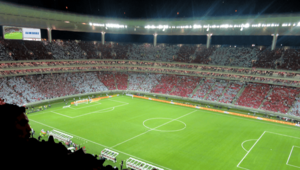
In 2010, Las Chivas's new home field was finished. It was first called Estadio Omnilife. The stadium was designed to look like a volcano with a cloud on top. This design helps it blend in with nature nearby. It is also used for events and business meetings.
Building the stadium started in May 2007 and finished in July 2010. The seats are red, except for the special box seats, which are white. It has a large main entrance and 18 exits. The stadium can hold 49,850 people. This includes 330 private suites. There is underground parking for suite renters and a large parking lot outside. The stadium also has a store, a museum, and places to buy food and drinks.
The stadium opened on July 30, 2010. The first game was a friendly match between Chivas and Manchester United. Chivas won 3–2. Javier "Chicharito" Hernandez scored the first goal. In March 2016, the stadium was renamed Estadio Chivas. On November 10, 2017, it was announced that Grupo Akron would buy the naming rights. On December 15, 2017, the stadium was officially renamed Estadio Akron.
Team Rivalries
El Súper Clásico

Chivas has two very important rivalries. Their biggest rivalry is with Club América, a team from Mexico City. Their games are called El Súper Clásico. These matches happen at least twice a year and are a national derby. Both teams are the most successful and popular in Mexico.
The rivalry grew after their second match, where Club América won 7–2. In the 1980s, fights broke out between the teams during games. This made the rivalry even more exciting for fans. Today, El Clásico de Clásicos creates huge excitement across Mexico and among fans worldwide. No matter how well the teams are doing, their game is always considered the most important of the season. El Súper Clásico was ranked 12th on a list of the 50 biggest derbies in football.
El Clásico Tapatío
The Clásico Tapatío is the oldest derby in Mexican football. It started in 1916. This game is played with great passion by fans of both Chivas and Club Atlas. Early in the rivalry, Guadalajara fans called Atlas players "Margaritas." In response, Atlas fans called their rivals "Chivas Locas" (Crazy Goats). At first, "Chivas" was an insult. But over time, it became a loving nickname for Chivas fans because of the club's popularity. Both teams used to share Estadio Jalisco. This caused some problems with fans. But in 2010, Chivas moved to the Estadio Akron.
Fan Support
Surveys say Chivas is the most popular football team in Mexico. Their fans remain loyal, even though the club has won only four championships since its golden age in 1970.
Fans love the team because of its successful past, the Campeonísimo era. Also, Chivas is the only top-division club in Mexico that only signs local players. They mostly focus on developing young talent from their own region, especially from Jalisco.
Supporter Groups
Chivas Guadalajara has three main supporter groups, also known as barra bravas: La Irreverente, Barra Insurgencia, and Legión 1908.
Team Management
Management Staff
Source: [1]
Coaching Staff
| Position | Staff |
|---|---|
| Manager | |
| Assistant managers | |
| Vacant | |
| Goalkeeper coach | |
| Fitness coaches | Vacant |
| Physiotherapist | |
| Team doctors | |
Players
First-Team Squad
|
|
Players on Loan
|
|
Reserve Teams
- Tapatío: This is the reserve team that plays in the Liga de Expansión MX, which is the second level of Mexican football.
- Álamos F.C.: This reserve team plays in the Liga TDP, the fourth level of the Mexican league system.
Player Records
Top Scorers in a Single Season
| Rank | Name | Season | Goals |
|---|---|---|---|
| 1 | Adalberto López | 1953–54 | 21 |
| 2 | Salvador Reyes | 1970–71 | 21 |
| 3 | Crescencio Gutiérrez | 1956–57 | 19 |
| 4 | Alan Pulido | Apertura 2019 | 12 |
| 5 | Omar Bravo | Clausura 2007 | 11 |
All-Time Records
Players in bold are still active with the team.
|
|
Retired Jersey Numbers
- 8 –
 Salvador Reyes (forward, 1953–1967, 2008) – This number was retired in January 2013 to honor him.
Salvador Reyes (forward, 1953–1967, 2008) – This number was retired in January 2013 to honor him. - 12 –
 This number is dedicated to the fans, who are seen as the 12th player on the team.
This number is dedicated to the fans, who are seen as the 12th player on the team. - 22 –
 José Martínez González (midfielder, 1970–81) – This number was retired in his memory after he passed away.
José Martínez González (midfielder, 1970–81) – This number was retired in his memory after he passed away.
Manager History
| Date | Name |
|---|---|
| 1943–44 | |
| 1943–45 | |
| 1946 | |
| 1946–49 | |
| 1949 | |
| 1949–50 | |
| 1950–51 | |
| 1951–56 | |
| 1956 | |
| 1956–57 | |
| 1957–59 | |
| 1959 | |
| 1959–60 | |
| 1960–70 | |
| 1970 | |
| 1970–73 | |
| 1973 | |
| 1973–74 | |
| 1974 | |
| 1974–75 | |
| 1975 | |
| 1975–76 | |
| 1976–78 | |
| 1978–79 | |
| 1979–80 | |
| 1980–82 | |
| 1982–89 | |
| 1 July 1989 – 30 June 1991 | |
| 1990 | |
| 1990 | |
| 1990–91 | |
| 1991–93 | |
| 1993 | |
| 1993–95 | |
| 1 July 1995 – 30 Oct 1995 | |
| 4 Nov 1995 – 30 June 1996 | |
| 1 July 1996 – 30 June 2000 | |
| 1 July 2000 – 22 Aug 2000 | |
| 2000–01 | |
| 2001 | |
| 2001–02 | |
| 1 July 2002 – 31 Dec 2002 | |
| 1 Jan 2003 – 29 Sept 2003 | |
| 1 Oct 2003 – 30 April 2004 | |
| 1 July 2004 – 14 Aug 2005 | |
| 2005 | |
| 2005 | |
| 1 Jan 2006 – 16 March 2006 | |
| 17 March 2006 – 24 Sept 2007 | |
| 28 Sept 2007 – 23 March 2009 | |
| 30 March 2009 – 16 April 2009 | |
| 16 April 2009 – 12 Sept 2009 | |
| 16 Sept 2009 – 3 Nov 2009 | |
| 3 Nov 2009 – 4 Oct 2011 | |
| 4 Oct 2011 – 22 Jan 2012 | |
| 25 Jan 2012 – 19 April 2012 | |
| 19 April 2012 – 30 June 2012 | |
| 1 July 2012 – 3 Jan 2013 | |
| 3 Jan 2013 – 18 Aug 2013 | |
| 19 Aug 2013 – 24 Nov 2013 | |
| 25 Nov 2013 – 2 April 2014 | |
| 2 April 2014 – 30 April 2014 | |
| 12 May 2014 – 2 Oct 2014 | |
| 3 Oct 2014 – 6 Oct 2014 | |
| 7 Oct 2014 – 14 Sept 2015 | |
| 15 Sept 2015 | |
| 15 Sept 2015 – 11 June 2018 | |
| 12 June 2018 – 31 March 2019 | |
| 6 Oct 2018 – April 2019 | |
| 10 April 2019 – 26 September 2019 | |
| 26 September 2019 – 9 August 2020 | |
| 9 August 2020 – 13 August 2020 | |
| 13 August 2020 – 19 September 2021 | |
| 19 September 2021 – 14 April 2022 | |
| 14 April 2022 – 9 October 2022 | |
| 31 October 2022 – 15 December 2023 | |
| 20 December 2023 – 10 October 2024 | |
| 10 October 2024 – 21 November 2024 | |
| 2 December 2024 - 3 March 2025 | |
| 3 March 2025 - 21 April 2025 |
Team Achievements
National Titles
| Type | Competition | Titles | Winning editions | Runners-up |
|---|---|---|---|---|
Top division |
Primera División/Liga MX | 12 | 1956–57, 1958–59, 1959–60, 1960–61, 1961–62, 1963–64, 1964–65, 1969–70, 1986–87, Verano 1997, Apertura 2006, Clausura 2017 | 1951–52, 1954–55, 1962–63, 1968–69, México 1970, 1982–83, 1983–84, Invierno 1998, Clausura 2004, Clausura 2023 |
| Copa México/Copa Presidente/Copa MX | 4 | 1962–63, 1969–70, Apertura 2015, Clausura 2017 | 1947–48, 1950–51, 1951–52, 1953–54, 1954–55, 1966–67, Clausura 2015, Apertura 2016 | |
| Campeón de Campeones | 7s | 1957, 1959, 1960, 1961, 1964, 1965, 1970 | 1962, 1963, 2017 | |
| Supercopa MX | 1s | 2016 | – |
International Titles
| Type | Competition | Titles | Winning editions | Runners-up |
|---|---|---|---|---|
Continental CONCACAF |
CONCACAF Champions Cup/Champions League | 2 | 1962, 2018 | 1963, 2007 |
| Continental CONMEBOL | CONMEBOL Libertadores | 0 | – | 2010 |
| Regional CCCF NAFC |
Campeonato Centroamericano | 0 | – | 1959 |
Amateur Titles
- Liga Occidental De Jalisco: 1908–09, 1909–10, 1911–12, 1921–22, 1922–23, 1923–24, 1924–25, 1927–28, 1928–29, 1929–30, 1932–33, 1934–35, 1937–38
- Campeón de Campeones de la Liga Occidental: 1932–33
- Torneo de una Tarde: 1929–30
- Torneo de Primavera: 1917
Friendly Titles
- Copa Reforma: 1911
- Copa Militarización: 1918
- Copa Deportivo Nacional de Torreón: 1919
- Copa Eugenio Pinzón: 1921
- Copa Francia: 1921–22
- Copa Fábricas de Francia: 1924
- Copa Presidencial: 1953
- Copa de Oro de Occidente: 1954, 1955, 1956, 1960
- Torneo Pentagonal Internacional de la Ciudad de México: 1958, 1961
- Trofeo Don Adolfo López Mateos: 1959, 1960, 1961, 1963
- Torneo de la Ciudad de Guadalajara: 1961
- Torneo Pentagonal Internacional de Jalisco: 1962
- California Cup: 1977
- Torneo Cuadrangular Fiestas de Octubre de Guadalajara: 1982
- Los Angeles International Quadrangular: 1982
- Copa Europa: 1985
- Torneo Cuadrangular Internacional Jalisciense: 1994
- Copa Tecate: 1994, 2001
- Copa Coliseo:1998
- Copa Estrella del Milenio: 1999
- Copa Informador de Fútbol: 1999
- Copa Pachuca: 1999
- Copa León: 2003
- Copa Marval: 2009
- Copa Gol Marketing: 2011
- Copa Jalisco: 2013
- Copa Duelo de Gigantes: 2017
- Supercopa Tecate: 2017
- Copa Árbol de Gernika: 2023
- Copa Morelos: 2025
International Game Records
| Season | Competition | Round | Club | Home | Away | Agg. / Pos. |
|---|---|---|---|---|---|---|
| 1959 | Campeonato Centroamericano | Round-Robin | 1–1 | |||
| 3–2 | ||||||
| 1–1 | ||||||
| 1962 | CONCACAF Champions' Cup | First round | 2–0 | 3–0 | 5–0 | |
| Final | 5–0 | 1–0 | 6–0 | |||
| 1963 | CONCACAF Champions' Cup | Second round | 2–0 | 0–0 | 2–0 | |
| Semi-finals | 2–0 | 1–0 | 3–0 | |||
| Final | Cancelled1 | |||||
| 1984 | CONCACAF Champions' Cup | First round | 3–0 | 4–2 | 7–2 | |
| Second round | Walkover2 | |||||
| Third round | 4–1 | 0–0 | 4–1 | |||
| Fourth round | Cancelled3 | |||||
| 1985 | CONCACAF Champions' Cup | First round | 1–1 | 1–3 | 2–4 | |
| 1997 | CONCACAF Champions' Cup | Quarter-final | 1–0 | |||
| Semi-final | 2–3 | |||||
| Third place | 2–2 4 | |||||
| 1998 | Copa Libertadores | Pre-Libertadores | 4–1 | 3–2 | 1st | |
| 4–1 | 1–1 | |||||
| Group 2 | 0–1 | 0–2 | 4th | |||
| 1–0 | 0–2 | |||||
| 1–0 | 0–2 | |||||
| 2000 | Copa Merconorte | Group A | 1–1 | 0–1 | 1st | |
| 4–0 | 3–2 | |||||
| 1–0 | 3–3 | |||||
| Semi-finals | 1–1 | 3–3 | 4–4 (2–4 p) | |||
| 2001 | CONCACAF Giants Cup | Quarter-finals | 1–1 | 1–3 | 2–4 | |
| Copa Merconorte | Group B | 3–0 | 0–25 | 4th | ||
| 0–25 | 0–2 | |||||
| 0–25 | 0–25 | |||||
| 2005 | Copa Libertadores | Preliminary round | 3–1 | 5–1 | 8–2 | |
| Group 7 | 3–1 | 3–1 | 1st | |||
| 0–0 | 2–4 | |||||
| 2–1 | 0–0 | |||||
| Round of 16 | 3–1 | 1–1 | 4–2 | |||
| Quarter-finals | 4–0 | 0–0 | 4–0 | |||
| Semi-finals | 2–2 | 0–3 | 2–5 | |||
| 2006 | Copa Libertadores | First stage | 5–3 | 3–1 | 8–4 | |
| Group 1 | 0–0 | 1–0 | 2nd | |||
| 1–1 | 0–0 | |||||
| 2–1 | 2–1 | |||||
| Round of 16 | 3–0 | 1–3 | 4–3 | |||
| Quarter-finals | 0–0 | 2–1 | 2–1 | |||
| Semi-finals | 0–1 | 0–3 | 0–4 | |||
| 2007 | CONCACAF Champions' Cup | Quarter-finals | 3–0 | 1–2 | 4–2 | |
| Semi-finals | 2–1 | 1–1 | 3–2 | |||
| Final | 2–2 | 0–0 | 2–2 (aet) (6–7 p) | |||
| Copa Sudamericana | Round of 16 | 1–0 | 2–1 | 2–2 (a) | ||
| Quarter-finals | 1–3 | 0–0 | 1–3 | |||
| 2008 | Copa Libertadores | Group 6 | 2–0 | 3–0 | 3rd | |
| 3–2 | 0–1 | |||||
| 0–1 | 0–1 | |||||
| Copa Sudamericana | First Stage | 1–1 | 2–1 | 3–2 | ||
| Round of 16 | 2–2 | 4–3 | 6–5 | |||
| Quarter-finals | 2–2 | 2–1 | 4–3 | |||
| Semi-finals | 0–2 | 0–4 | 0–6 | |||
| 2009 | Copa Libertadores | Group 6 | 0–0 | 1–1 | 2nd | |
| 6–2 | 1–1 | |||||
| 1–0 | 0–2 | |||||
| Round of 16 | Walkover6 | |||||
| 2010 | Copa Libertadores6 | Round of 16 | 3–0 | 0–2 | 3–2 | |
| Quarter-finals | 3–0 | 0–2 | 3–2 | |||
| Semi-finals | 1–1 | 2–0 | 3–1 | |||
| Final | 1–2 | 2–3 | 3–5 | |||
| 2012 | Copa Libertadores | Group 7 | 1–1 | 0–5 | 4th | |
| 0–2 | 0–3 | |||||
| 1–0 | 0–1 | |||||
| CONCACAF Champions League | Group 8 | 2–1 | 0–1 | 2nd | ||
| 4–0 | 1–1 | |||||
| 2018 | CONCACAF Champions League | Round of 16 | 5–0 | 2–0 | 7–0 | |
| Quarter-finals | 3–0 | 0–1 | 3–1 | |||
| Semi-finals | 1–0 | 0–0 | 1–0 | |||
| Final | 1–2 | 2–1 | 3–3 (4–2 p) | |||
| FIFA Club World Cup | Second round | 2–3 | ||||
| Fifth place | 1–1 (5–6 p) | |||||
| 2023 | Leagues Cup | Central 3 | 1–3 | 3rd | ||
| 0–1 | ||||||
| 2024 | CONCACAF Champions Cup | Round One | 2–1 | 3–1 | 5–2 | |
| Round of 16 | 0–3 | 3–2 | 3–5 | |||
| Leagues Cup | West 2 | 1–1 (3–4 p) | 3rd | |||
| 2–2 (4–5 p) | ||||||
| 2025 | CONCACAF Champions Cup | Round One | 3–0 | 1–1 | 4–1 | |
| Round of 16 | 1–0 | 0–4 | 1–4 | |||
| Leagues Cup | Eastern 3 | |||||
1 Guadalajara had to leave the competition because they were on a tour in Europe when the finals were scheduled.
2 Jacksonville pulled out, so Guadalajara moved forward.
3 Both clubs were removed from the competition because they could not agree on game dates.
4 Third place was shared between the teams.
5 Guadalajara was removed from the competition by CONMEBOL. This happened after they refused to play their match against the MetroStars in New York. They lost their last 4 matches with a score of 0–2.
6 São Paulo refused to travel because of worries about the H1N1 flu in Mexico. Guadalajara then left the tournament. CONMEBOL later gave Guadalajara a spot in the round of 16 for the 2010 competition instead.
See also
 In Spanish: Club Deportivo Guadalajara (México) para niños
In Spanish: Club Deportivo Guadalajara (México) para niños


